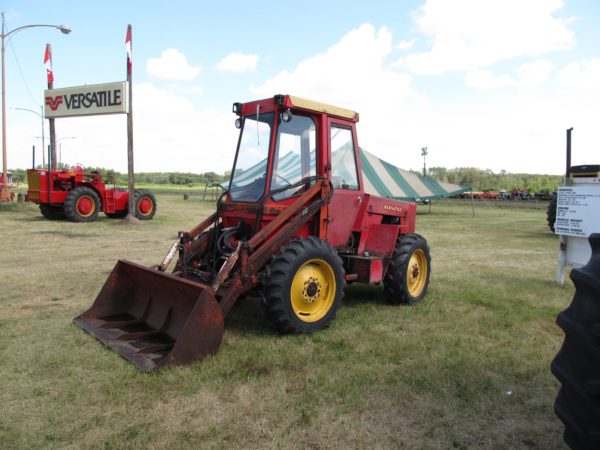In the mid-1980s, with the sale of Versatile to Ford, the backlot of Versatile was cleaned out. Two prototype tractors were donated to the Manitoba Agricultural Museum at that time, one famous as being a contender for the title of the world’s largest tractor, the four-axle, 500-horsepower Model 1080 tractor, and a tractor that was one of the prototypes for what became Versatile’s Model 150 bi-directional tractor.
Daniel Pakosh, brother to one of the founders of Versatile, came up with a simple idea in the late 1960s. Why not design a loader to fit the rear of a tractor and design the operator’s station so it would swivel to the rear when the operator wanted to use the loader? This idea appeared to offer some advantages, shorter and stronger loader arms, better visibility and better balance on the wheels. With some more thought on the idea, it was realized that the design could also be modified to offer push – pull operation as desired. This arrangement meant a bi-directional tractor could serve as the tractor unit for a self propelled swather. After the swathing duties were over, the header designed for the bi-directional could be removed and the tractor could then be used to pull a harrow bar, perform loader duties or whatever the farmer needed.
As Versatile in the 1970s offered a wide range of four wheel drive tractors all over 100 horsepower, a tractor under 100 horsepower was thought desirable to fill the product line in. As well it was thought a smaller tractor was more suitable for loader duties, swathing and other duties that a bi-directional tractor was most suited to. Versatile was also a believer in the application of hydrostatic transmissions to farm machinery and it was a natural that a Versatile wanted a hydrostatic transmission in the bi-directional tractor design, particularly for loader operation. As Versatile was a pioneer in articulated, four wheel drive tractors, again it was a natural the design would feature four wheel drive and articulated steering.

By 1977, Versatile had finalized a design, the Model 150, and put it into production. The 150 enjoyed good sales success and not only with farmers but with municipalities who appreciated the versatility of a bi-directional combined with Versatile’s rugged, simple design philosophy. However Versatile did not stand on its laurels and improved the concept. The 150 was replaced in 1984 with a new design which offered PTOs, three point linkages and hydraulic outlets on either end, the Model 256.
The Versatile Bi-Directional in the Manitoba Agricultural Museum’s collection appears to be a prototype as it has a number of features that do not appear on the production Model 150. Most noticeably the hydraulic pump is mounted near the articulating hinge and hangs out on the side of the tractor. Obviously in this position the pump would be prone to damage. It may have been there was a previous prototype bi-directional as this particular tractor does not show much evidence of cutting and re-welding of the frame to accommodate design changes. The Model 1080 better known as Big Roy, also a prototype, shows significant cutting and re-welding of the frame to accommodate changes and new components. After the design department was done with the machine rather than being scrapped, the Bi-Directional was used to plow snow at the Versatile plant and for other light duties. When the Versatile Company was sold to Ford, the tractor became surplus and was donated to the Museum.


